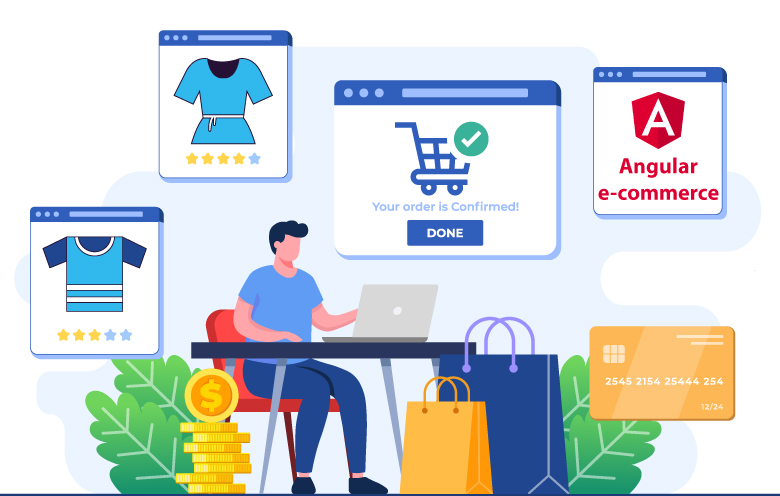It’s interesting to consider how a business owner looking to build an e-commerce platform and a real-estate mogul constructing a mall face similar challenges. Both require a strong architectural foundation capable of supporting expansion, handling both anticipated and fluctuating foot traffic, and ensuring visitor safety and security. If growth, scalability, and safeguarding your business are priorities, while architects opt for reinforced concrete, Angular development services are the safest bet for building a robust online store.
Over 75,888 websites in the United States alone use the Angular platform for website development – SimilarTech
But what makes Angular the primary choice for developers, especially in the case of an e-commerce website? In this deliberation, we will explore the significant advantages Angular brings to business owners, its appeal as a preferred choice for developers in e-commerce web application development, and the key steps involved in creating a powerful Angular e-commerce application.
Benefits of Angular e-commerce for business owners:
-
Scalability: Angular enables your e-commerce platform to grow with your business. It can handle large product catalogs, increased traffic, and the evolving needs of a growing business without compromising performance. Its flexible architecture ensures your platform remains stable even as the demands increase, making it a future-proof solution.
-
Faster time to market: Angular’s modular architecture enables quicker development cycles. By choosing to hire an Angular developer, businesses can achieve swift iterations and launch their e-commerce platforms faster. This gives them a competitive edge and allows them to capitalize on market opportunities while responding swiftly to customer demands, increasing adaptability.
-
Enhanced customer engagement: The framework supports building highly responsive web apps, ensuring seamless user experience across devices, which helps in retaining customers and reducing bounce rates. A smooth and engaging interface not only fosters loyalty but also enhances user satisfaction, leading to higher conversions – making Angular for e-commerce an optimal choice for businesses.
-
Cost efficiency: Angular has reduced the amount of manual coding required and has simplified updates. This minimizes development and maintenance costs. Hence, it has has established itself as an economical choice for long-term projects in e-commerce web application development. Angular further cuts down on resources required due to it’s ability to streamline workflows and automate repetitive tasks, ensuring businesses save both time and money.
-
Improved web security: Security is paramount for e-commerce platforms, especially when handling online payments. Every transaction leaves behind a trail of sensitive customer data. Since customer loyalty heavily depends on trust and security, safeguarding this information is crucial for any online retailer. Angular helps protect your customer data and shields your website from fraud. With features like secure code variables and built-in security attributes, including HTTP, Angular ensures your e-commerce platform meets the highest security standards.
-
SEO-friendly: From the visibility perspective, perfecting the art of search engine optimization (SEO) is very crucial for the success of any e-commerce platform. Ranking higher on search engines translates to more organic traffic. This directly impacts the sales. Angular supports your SEO efforts with built-in capabilities that make your site more discoverable. By leveraging Angular’s SEO-friendly features, your website can rank higher, drawing in more customers and boosting its visibility.
Suggested: Explore Angular 18: Top features and updates for enhanced development
Why choose Angular for your e-commerce web app development?
-
Component-based architecture: Angular employs the MVC (Model-View-Controller) architecture, allowing developers to break down the application into modular components. This enables the creation of faster, more efficient applications. The component-based structure also enhances code reusability and maintainability, streamlining the development of complex e-commerce apps, while ensuring performance remains high. These features collectively illustrate the benefits of Angular e-commerce for developers, empowering them to deliver high-quality solutions effectively.
-
Low code framework: Angular offers a simplified framework and eliminates the need for extensive coding. Its minimal code requirements make it easy for developers to understand and implement, speeding up the application development process. By eliminating the need to rebuild the MVC architecture, Angular allows developers to focus on creating powerful applications in less time.
-
Two-way data binding: This feature ensures that any changes in the application’s interface are instantly reflected in the underlying data model. This provides users an instant feedback which makes the interaction more interactive. Consistent and synchronized information across the interface minimizes confusion and improves user confidence. Thus, the user engagement is significantly enhanced which is one of the key advantages of Angular e-commerce development.
-
Built-in SEO support: An online store relies heavily on search engine visibility. Angular now offers built-in features to make single-page applications (SPAs) more SEO-friendly. This feature enhances the ability of search engines to index Angular apps, thus improving organic search rankings that drive more traffic and boosts sales potential.
-
Cross-platform development: Angular supports the development of web and mobile apps with a unified codebase, allowing businesses to expand into mobile commerce easily. This capability reduces development effort and ensures consistent user experience across platforms, making it a highly efficient choice for multi-channel e-commerce strategies.
-
Efficient testing cycle: Testing and quality assurance are integral to any successful app development process. Angular provides a comprehensive unit testing setup, making it easier to identify and address bugs or performance issues. This testing efficiency ensures your application runs smoothly, giving developers valuable insights into the quality and reliability of the code before launch, which underscores the benefits of Angular e-commerce for developers.
Steps to develop Angular e-commerce application:
The following steps outline how to effectively utilize Angular’s capabilities to build a high-performing e-commerce platform that follows a systemic process to impart scalability, security, and an enhanced user experience:
Step 1: Set up your development environment
Install Node.js from the official site and Angular CLI with the command:
npm install -g @angular/cli
Step 2: Create a new Angular project
1. Create the project: Create a new Angular project for your eCommerce application to initialize the setup and prepare the necessary files:
ng new e-commerce-project
cd e-commerce-project
2. Run the development server: After creating the project, launch the development server to preview your application in your default web browser:
ng serve
Step 3: Set up Angular routing
1. Generate routing module: Create a routing module to manage navigation within your Angular eCommerce application, allowing seamless transitions between views and components.
ng generate module app-routing --flat --module=app
2. Define routes: Update app-routing.module.ts to include routes for your components:
Next, you'll define the routes for the various components, such as home, product list, product detail, and cart, to ensure smooth navigation.
import { NgModule } from '@angular/core';
import { RouterModule, Routes } from '@angular/router';
import { HomeComponent } from './home/home.component';
import { ProductListComponent } from './product-list/product-list.component';
import { ProductDetailComponent } from './product-detail/product-detail.component';
import { CartComponent } from './cart/cart.component';
const routes: Routes = [
{ path: '', component: HomeComponent },
{ path: 'products', component: ProductListComponent },
{ path: 'product/:id', component: ProductDetailComponent },
{ path: 'cart', component: CartComponent },
];
@NgModule({
imports: [RouterModule.forRoot(routes)],
exports: [RouterModule]
})
export class AppRoutingModule { }
Step 4: Create components
Generate components for the homepage, product list, product details, and cart:
ng generate component home
ng generate component product-list
ng generate component product-detail
ng generate component cart
Step 5: Build a product model: In src/app/, create a file called product.model.ts:
Create a product model for defining your eCommerce products:
export interface Product {
id: number;
name: string;
price: number;
description?: string;
imageUrl?: string;
}
Step 6: Create a product service
1. Generate the product service: In this step, you'll generate a service that will handle the product data logic within your Angular eCommerce application.
ng generate service product
2. Implement the product service: In product.service.ts, manage product data:
Next, you'll implement the service to manage product information, including retrieving a list of products and fetching individual product details.
import { Injectable } from '@angular/core';
import { Product } from './product.model';
@Injectable({
providedIn: 'root'
})
export class ProductService {
private products: Product[] = [
{ id: 1, name: 'Product 1', price: 100, description: 'Description 1', imageUrl: 'url1' },
{ id: 2, name: 'Product 2', price: 150, description: 'Description 2', imageUrl: 'url2' },
// Add more products as needed
];
getProducts(): Product[] {
return this.products;
}
getProductById(id: number): Product {
return this.products.find(product => product.id === id);
}
}
Step 7: Create a cart service
1. Generate the cart service: In this phase, you'll create a service that will handle all the cart-related functionality for your eCommerce application.
ng generate service cart
2. Implement the cart service: In cart.service.ts, manage cart operations:
Following the generation, you'll implement the service to manage cart operations like adding items, retrieving cart contents, and clearing the cart.
import { Injectable } from '@angular/core';
import { Product } from './product.model';
@Injectable({
providedIn: 'root'
})
export class CartService {
private cart: Product[] = [];
addToCart(product: Product) {
this.cart.push(product);
}
getCartItems(): Product[] {
return this.cart;
}
clearCart() {
this.cart = [];
}
}
Step 8: Implement the user interface
1. Install Angular material (optional, for UI components): Begin by adding Angular Material to enhance the visual design of your eCommerce app with pre-built UI components.
ng add @angular/material
2. Design product list component: In product-list.component.ts, fetch and display products:
Proceed by fetching product data and displaying it in the product list component, allowing users to view items and interact with the cart.
import { Component, OnInit } from '@angular/core';
import { ProductService } from '../product.service';
import { Product } from '../product.model';
@Component({
selector: 'app-product-list',
templateUrl: './product-list.component.html',
styleUrls: ['./product-list.component.css']
})
export class ProductListComponent implements OnInit {
products: Product[] = [];
constructor(private productService: ProductService) {}
ngOnInit(): void {
this.products = this.productService.getProducts();
}
addToCart(product: Product) {
// Logic to add product to cart
}
}
3. Display products using mat-card: In product-list.component.html, display products using mat-card:
Use Angular material's mat-card in product-list.component.html to elegantly showcase each product, enhancing the user experience with a visually appealing layout.
<mat-card *ngFor="let product of products">
<mat-card-title>{{ product.name }}</mat-card-title>
<mat-card-content>
<p>Price: {{ product.price | currency }}</p>
<button mat-button (click)="addToCart(product)">Add to Cart</button>
</mat-card-content>
</mat-card>
Step 9: Implement cart functionality
1. Design cart component: In cart.component.ts, create the Cart component to manage and display items added to the cart. This component fetches the cart items from the CartService and provides functionality to clear the cart:
import { Component, OnInit } from '@angular/core';
import { CartService } from '../cart.service';
import { Product } from '../product.model';
@Component({
selector: 'app-cart',
templateUrl: './cart.component.html',
styleUrls: ['./cart.component.css']
})
export class CartComponent implements OnInit {
cartItems: Product[] = [];
constructor(private cartService: CartService) {}
ngOnInit(): void {
this.cartItems = this.cartService.getCartItems();
}
clearCart() {
this.cartService.clearCart();
this.cartItems = [];
}
}
2. Display cart items: In cart.component.html, list the products in the cart using mat-list, allowing users to easily view their selected items along with a button to clear the cart:
<h2>Your Cart</h2>
<mat-list>
<mat-list-item *ngFor="let item of cartItems">
{{ item.name }} - {{ item.price | currency }}
</mat-list-item>
</mat-list>
<button mat-button (click)="clearCart()">Clear Cart</button>
Step 10: Test your application
Run the application to ensure everything works correctly:
ng serve
Verify that the product list is visible and that items can be added to or removed from the cart.
Step 11: Deploy your application
Once tested, build the application for production:
ng build --prod
By following these steps, you will successfully develop your Angular e-commerce application. Once tested, you can deploy the output from the dist/ folder to platforms like Firebase Hosting, Vercel, or Netlify, bringing your e-commerce solution to life in the online marketplace.
Takeaway points
Choosing the right technology for your e-commerce platform serves as the foundational step that makes all the difference in today’s competitive landscape. Renowned designer and architect Charles Eames once said, “The details are not the details. They make the design.” Angular provides robust scalability, flexibility, and security that businesses need to meet the evolving demands of modern consumers. Its cross-platform capabilities, SEO enhancements, and simplified development process enable both developers and businesses to create future-proof solutions that not only meet current requirements but are also prepared for growth. By embracing Angular for your e-commerce needs, you ensure that every detail contributes to a cohesive and effective online presence.
At Softweb Solutions, our specialists capitalize on the strengths of Angular e-commerce development to deliver dynamic, secure, and high-performing platforms that drive business success. Let us help you unlock the full potential of your e-commerce vision.



